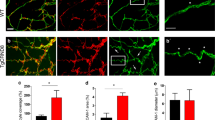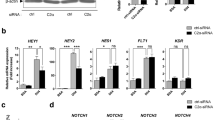Abstract
Presenilin-1 (PS1) gene encodes the catalytic component of γ-secretase, which proteolytically processes several type I transmembrane proteins. We here present evidence that the cytosolic peptide efnB2/CTF2 produced by the PS1/γ-secretase cleavage of efnB2 ligand promotes EphB4 receptor-dependent angiogenesis in vitro. EfnB2/CTF2 increases endothelial cell sprouting and tube formation, stimulates the formation of angiogenic complexes that include VE-cadherin, Raf-1 and Rok-α, and increases MLC2 phosphorylation. These functions are mediated by the PDZ-binding domain of efnB2. Acute downregulation of PS1 or inhibition of γ-secretase inhibits the angiogenic functions of EphB4 while absence of PS1 decreases the VE-cadherin angiogenic complexes of mouse brain. Our data reveal a mechanism by which PS1/γ-secretase regulates efnB2/EphB4 mediated angiogenesis.








Similar content being viewed by others
Abbreviations
- EfnB2:
-
EphrinB2
- CTF2:
-
Carboxy terminal fragment 2
- CTF1:
-
Carboxy terminal fragment 1
- PS1:
-
Presenilin1
- WT:
-
Wild type
- KO:
-
Knockout
- VE-cadherin:
-
Vascular Endothelial cadherin
- N-cad:
-
Neuronal cadherin
- Rap1:
-
Ras-proximate-1 or Ras-related protein 1
- Rok-α:
-
Rho-associated, coiled-coil-containing protein kinase 2
- BAMEC:
-
Bovine adrenal microvessel endothelial cells
- MLC2:
-
Myosin light chain 2
- FAD:
-
Familial Alzheimer’s disease
- AD:
-
Alzheimer’s disease
References
Barthet G, Georgakopoulos A, Robakis NK (2012) Cellular mechanisms of gamma-secretase substrate selection, processing and toxicity. Prog Neurobiol 98(2):166–175. https://doi.org/10.1016/j.pneurobio.2012.05.006
Shen J, Bronson RT, Chen DF, Xia W, Selkoe DJ, Tonegawa S (1997) Skeletal and CNS defects in Presenilin-1-deficient mice. Cell 89(4):629–639
Nakajima M, Yuasa S, Ueno M, Takakura N, Koseki H, Shirasawa T (2003) Abnormal blood vessel development in mice lacking presenilin-1. Mech Dev 120(6):657–667
Gama Sosa MA, Gasperi RD, Rocher AB, Wang AC, Janssen WG, Flores T, Perez GM, Schmeidler J, Dickstein DL, Hof PR, Elder GA (2010) Age-related vascular pathology in transgenic mice expressing presenilin 1-associated familial Alzheimer’s disease mutations. Am J Pathol 176(1):353–368. https://doi.org/10.2353/ajpath.2010.090482
Gerety SS, Wang HU, Chen ZF, Anderson DJ (1999) Symmetrical mutant phenotypes of the receptor EphB4 and its specific transmembrane ligand ephrin-B2 in cardiovascular development. Mol Cell 4(3):403–414
Adams RH, Diella F, Hennig S, Helmbacher F, Deutsch U, Klein R (2001) The cytoplasmic domain of the ligand ephrinB2 is required for vascular morphogenesis but not cranial neural crest migration. Cell 104(1):57–69
Wimmer R, Cseh B, Maier B, Scherrer K, Baccarini M (2012) Angiogenic sprouting requires the fine tuning of endothelial cell cohesion by the Raf-1/Rok-alpha complex. Dev Cell 22(1):158–171. https://doi.org/10.1016/j.devcel.2011.11.012
Abraham S, Yeo M, Montero-Balaguer M, Paterson H, Dejana E, Marshall CJ, Mavria G (2009) VE-Cadherin-mediated cell-cell interaction suppresses sprouting via signaling to MLC2 phosphorylation. Curr Biol 19(8):668–674. https://doi.org/10.1016/j.cub.2009.02.057
Georgakopoulos A, Litterst C, Ghersi E, Baki L, Xu C, Serban G, Robakis NK (2006) Metalloproteinase/presenilin1 processing of ephrinB regulates EphB-induced Src phosphorylation and signaling. EMBO J 25(6):1242–1252. https://doi.org/10.1038/sj.emboj.7601031
Nehls V, Drenckhahn D (1995) A novel, microcarrier-based in vitro assay for rapid and reliable quantification of three-dimensional cell migration and angiogenesis. Microvasc Res 50(3):311–322. https://doi.org/10.1006/mvre.1995.1061
Eilken HM, Adams RH (2010) Dynamics of endothelial cell behavior in sprouting angiogenesis. Curr Opin Cell Biol 22(5):617–625. https://doi.org/10.1016/j.ceb.2010.08.010
Madri JA, Pratt BM, Tucker AM (1988) Phenotypic modulation of endothelial cells by transforming growth factor-beta depends upon the composition and organization of the extracellular matrix. J Cell Biol 106(4):1375–1384
Grant DS, Kibbey MC, Kinsella JL, Cid MC, Kleinman HK (1994) The role of basement membrane in angiogenesis and tumor growth. Pathol Res Pract 190(9–10):854–863
Makinen T, Adams RH, Bailey J, Lu Q, Ziemiecki A, Alitalo K, Klein R, Wilkinson GA (2005) PDZ interaction site in ephrinB2 is required for the remodeling of lymphatic vasculature. Genes Dev 19(3):397–410. https://doi.org/10.1101/gad.330105
Kida Y, Ieronimakis N, Schrimpf C, Reyes M, Duffield JS (2013) EphrinB2 reverse signaling protects against capillary rarefaction and fibrosis after kidney injury. J Am Soc Nephrol 24(4):559–572. https://doi.org/10.1681/ASN.2012080871
Palmer A, Zimmer M, Erdmann KS, Eulenburg V, Porthin A, Heumann R, Deutsch U, Klein R (2002) EphrinB phosphorylation and reverse signaling: regulation by Src kinases and PTP-BL phosphatase. Mol Cell 9(4):725–737
Grigorian AL, Bustamante JJ, Hernandez P, Martinez AO, Haro LS (2005) Extraordinarily stable disulfide-linked homodimer of human growth hormone. Protein Sci 14(4):902–913. https://doi.org/10.1110/ps.041048805
Isbert S, Wagner K, Eggert S, Schweitzer A, Multhaup G, Weggen S, Kins S, Pietrzik CU (2012) APP dimer formation is initiated in the endoplasmic reticulum and differs between APP isoforms. Cell Mol Life Sci 69(8):1353–1375. https://doi.org/10.1007/s00018-011-0882-4
Chrzanowska-Wodnicka M (2010) Regulation of angiogenesis by a small GTPase Rap1. Vascul Pharmacol 53(1–2):1–10. https://doi.org/10.1016/j.vph.2010.03.003
Qian Y, Vogt A, Vasudevan A, Sebti SM, Hamilton AD (1998) Selective inhibition of type-I geranylgeranyltransferase in vitro and in whole cells by CAAL peptidomimetics. Bioorg Med Chem 6(3):293–299
Marambaud P, Wen PH, Dutt A, Shioi J, Takashima A, Siman R, Robakis NK (2003) A CBP binding transcriptional repressor produced by the PS1/epsilon-cleavage of N-cadherin is inhibited by PS1 FAD mutations. Cell 114(5):635–645
Liu Z, Tan JL, Cohen DM, Yang MT, Sniadecki NJ, Ruiz SA, Nelson CM, Chen CS (2010) Mechanical tugging force regulates the size of cell-cell junctions. Proc Natl Acad Sci USA 107(22):9944–9949. https://doi.org/10.1073/pnas.0914547107
Weis WI, Nelson WJ (2006) Re-solving the cadherin-catenin-actin conundrum. J Biol Chem 281(47):35593–35597. https://doi.org/10.1074/jbc.R600027200
Prevost N, Woulfe DS, Tognolini M, Tanaka T, Jian W, Fortna RR, Jiang H, Brass LF (2004) Signaling by ephrinB1 and Eph kinases in platelets promotes Rap1 activation, platelet adhesion, and aggregation via effector pathways that do not require phosphorylation of ephrinB1. Blood 103(4):1348–1355. https://doi.org/10.1182/blood-2003-06-1781
Georgakopoulos A, Xu J, Xu C, Mauger G, Barthet G, Robakis NK (2011) Presenilin1/gamma-secretase promotes the EphB2-induced phosphorylation of ephrinB2 by regulating phosphoprotein associated with glycosphingolipid-enriched microdomains/Csk binding protein. FASEB J 25(10):3594–3604. https://doi.org/10.1096/fj.11-187856
Kemmerling N, Wunderlich P, Theil S, Linnartz-Gerlach B, Hersch N, Hoffmann B, Heneka MT, de Strooper B, Neumann H, Walter J (2017) Intramembranous processing by gamma-secretase regulates reverse signaling of ephrin-B2 in migration of microglia. Glia 65(7):1103–1118. https://doi.org/10.1002/glia.23147
Boulton ME, Cai J, Grant MB (2008) gamma-Secretase: a multifaceted regulator of angiogenesis. J Cell Mol Med 12(3):781–795. https://doi.org/10.1111/j.1582-4934.2008.00274.x
Wang Y, Nakayama M, Pitulescu ME, Schmidt TS, Bochenek ML, Sakakibara A, Adams S, Davy A, Deutsch U, Luthi U, Barberis A, Benjamin LE, Makinen T, Nobes CD, Adams RH (2010) Ephrin-B2 controls VEGF-induced angiogenesis and lymphangiogenesis. Nature 465(7297):483–486. https://doi.org/10.1038/nature09002
Sawamiphak S, Seidel S, Essmann CL, Wilkinson GA, Pitulescu ME, Acker T, Acker-Palmer A (2010) Ephrin-B2 regulates VEGFR2 function in developmental and tumour angiogenesis. Nature 465(7297):487–491. https://doi.org/10.1038/nature08995
Leong KG, Hu X, Li L, Noseda M, Larrivee B, Hull C, Hood L, Wong F, Karsan A (2002) Activated Notch4 inhibits angiogenesis: role of beta 1-integrin activation. Mol Cell Biol 22(8):2830–2841
Zheng W, Tammela T, Yamamoto M, Anisimov A, Holopainen T, Kaijalainen S, Karpanen T, Lehti K, Yla-Herttuala S, Alitalo K (2011) Notch restricts lymphatic vessel sprouting induced by vascular endothelial growth factor. Blood 118(4):1154–1162. https://doi.org/10.1182/blood-2010-11-317800
Sainson RC, Aoto J, Nakatsu MN, Holderfield M, Conn E, Koller E, Hughes CC (2005) Cell-autonomous notch signaling regulates endothelial cell branching and proliferation during vascular tubulogenesis. FASEB J 19(8):1027–1029. https://doi.org/10.1096/fj.04-3172fje
Larrivee B, Prahst C, Gordon E, del Toro R, Mathivet T, Duarte A, Simons M, Eichmann A (2012) ALK1 signaling inhibits angiogenesis by cooperating with the Notch pathway. Dev Cell 22(3):489–500. https://doi.org/10.1016/j.devcel.2012.02.005
Adams RH, Wilkinson GA, Weiss C, Diella F, Gale NW, Deutsch U, Risau W, Klein R (1999) Roles of ephrinB ligands and EphB receptors in cardiovascular development: demarcation of arterial/venous domains, vascular morphogenesis, and sprouting angiogenesis. Genes Dev 13(3):295–306
Kitamura T, Koshino Y, Shibata F, Oki T, Nakajima H, Nosaka T, Kumagai H (2003) Retrovirus-mediated gene transfer and expression cloning: powerful tools in functional genomics. Exp Hematol 31(11):1007–1014
Acknowledgements
This work was supported by NIH Grants 2R01-NS047229-11, P50AG05138, AG-17926, AG-008200 and by Alzheimer’s Association Grant IIRG-11-205149.
Author information
Authors and Affiliations
Contributions
AG conceived the project, designed the research, supervised the project and wrote the manuscript with input from all authors. NW, GV, YY performed experiments and contributed to writing of the manuscript. NR supervised the work and contributed to research design and writing of the manuscript.
Corresponding author
Electronic supplementary material
Below is the link to the electronic supplementary material.
Rights and permissions
About this article
Cite this article
Warren, N., Voloudakis, G., Yoon, Y. et al. The product of the γ-secretase processing of ephrinB2 regulates VE-cadherin complexes and angiogenesis. Cell. Mol. Life Sci. 75, 2813–2826 (2018). https://doi.org/10.1007/s00018-018-2762-7
Received:
Revised:
Accepted:
Published:
Issue Date:
DOI: https://doi.org/10.1007/s00018-018-2762-7




